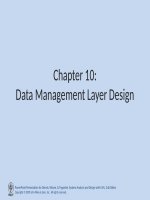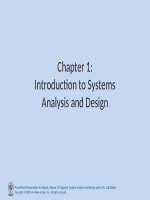Lecture Introduction to systems analysis and design Chapter 12 Whitten, Bentley
Bạn đang xem bản rút gọn của tài liệu. Xem và tải ngay bản đầy đủ của tài liệu tại đây (1.64 MB, 57 trang )
Chapter
Chapter 12
12
Application
Application Architecture
Architecture
and
and Modeling
Modeling
McGraw-Hill/Irwin
© 2008 The McGraw-Hill Companies, All Rights Reserved
12-2
Objectives
• Define an information system’s architecture in terms of the
KNOWLEDGE, PROCESSES, and COMMUNICATION building
blocks.
• Differentiate between logical and physical data flow diagrams,
and explain how physical data flow diagrams are used to
model an information system’s architecture.
• Describe centralized and distributed computing alternatives,
including client/server and Internet-based computing options.
• Describe database and data distribution alternatives for system
design.
• Describe user and system interface alternatives for system
design.
• Describe various software development environments for
information system design.
• Describe strategies for developing or determining architecture
of an information system.
• Draw physical data flow diagrams for an information system’s
architecture and processes.
12-3
Application Architecture
Application architecture – a specification of
the technologies to be used to implement
information systems. The blueprint to
communicate the following design decisions:
– The degree to which the information system will be
centralized or distributed.
– The distribution of stored data.
– The implementation technology for software
developed in-house.
– The integration of commercial off-the-shelf software.
– The technology to be used to implement the user
interface.
– The technology to be used to interface with other
systems
12-4
Physical Data Flow Diagram
(DFD)
Physical data flow diagram (DFDs) – a
process model used to communicate the
technical implementation characteristics of
an information system.
– Communicate technical choices and other
design decisions to those who will actually
construct and implement the system.
– Recall from Chapter 9 that DFDs are a type
of process model.
12-5
Sample Physical
Data Flow Diagram
12-6
Physical Processes
Physical process – either a processor, such as a
computer or person, or a technical implementation of
specific work to be performed, such as a computer
program or manual process.
– Logical processes may be assigned to physical processors
such as PCs, servers, people, or devices in a network. A
physical DFD would model that network structure.
– Each logical process requires an implementation as one or
more physical processes.
– A logical process may be split into multiple physical
processes:
•
•
•
•
To define aspects performed by people or computers.
To define aspects implemented by different technologies.
To show multiple implementations of the same process.
To add processes for exceptions and security.
12-7
Physical Process Notation
ID (optional)
Action Verb
+
Noun or Object
Phrase
Implementation
12-8
Samples of Physical Processes
12-9
Possible Computer Process
Implementations
• A purchased application software package
– Also called commercial off-the-shelf (COTS)
software
• A system or utility program
– Such as an e-mail/message server or third-party
framework
• An existing application program from a
program library
– May require modification
• A program to be written
12-10
Sample Physical Process
Implementations
12-11
Physical Data Flows
A physical data flow represents:
– Planned implementation of an input to, or
output from a physical process.
– Database command or action such as create,
read, update, or delete.
– Import of data from, or
Implementation method:
export of data to another
Data flow name
information system.
OR
– Flow of data between
two modules or
Data flow name
(Implementation method)
subroutines (represented
as physical processes).
12-12
Sample Physical Data Flows
12-13
Sample Physical Data Flows
(continued)
12-14
Physical External Agents
Physical external agents are carried over
from the logical DFD models.
– If scope changes, the logical models should
be changed before the physical models are
drawn.
12-15
Physical Data Stores
A physical data store represents the
planned implementation of one of:
– A database
– A table in a database
– A computer file
– A tape or media backup of anything
important
– A temporary file or batch
– Any type of noncomputerized file
12-16
Physical Data Store Notation
12-17
Physical Data Store
Implementations
12-18
Distributed versus Centralized
Systems
Distributed system – a system in which
components are distributed across multiple
locations and computer networks.
– Accordingly, the processing workload is distributed
across multiple computers on the network.
Centralized systems – a system in which all
components are hosted by a central, multi-user
computer.
– Users interact with the system via terminals (or a
PC emulating a terminal).
– Virtually all the actual processing and work is done
on the host computer.
12-19
Why the Trend Toward
Distributed Systems?
• Modern businesses are already decentralized
(distributed).
• Distributed computing moves information and services
closer to the customers and users who need them.
• Distributed computing consolidates the power of
personal computers across the enterprise.
• Distributed computing solutions are in general more
user-friendly because they use the PC as the user
interface processor.
• Personal computers and network servers are less
expensive than mainframe computers
– Though total cost of ownership is at least as expensive
12-20
Computing Layers
• Presentation layer—the user interface
• Presentation logic layer—processing that must be
done to generate the presentation, such as editing
input data or formatting output data.
• Application logic layer—the logic and processing to
support business rules, policies, and procedures
• Data manipulation layer—to store and retrieve data to
and from the database
• Data layer—the actual business data
12-21
Types of Distributed Computing
12-22
File Server Architecture
Local area network (LAN) – a set of client
computers (PCs) connected over a relatively
short distance to one or more servers.
File server system – a LAN in which a server
hosts the data of an information system.
– All other layers are implemented on the client
computers.
– Frequently excessive network traffic to transport
data between servers and clients.
– Client must be fairly robust (“fat”) because it does
most of the work.
– Database integrity can be compromised.
12-23
File Server Architecture
12-24
Client/Server Architecture —
Clients
Client/server system – a distributed computing
solution in which the presentation, presentation
logic, application logic, data manipulation, and
data layers are distributed between client PCs
and one or more servers.
Thin client – a personal
computer that does not
have to be very powerful
because it only presents
the user interface to the
user.
Fat client – a personal
computer, notebook
computer, or workstation
that is typically powerful.
12-25
Client/Server Architecture —
Servers
• Database server – a server that hosts one or more
databases and executes all data manipulation
commands at the server.
• Transaction server – a server that hosts services
which ensure that all database updates for a
transaction succeed or fail as a whole.
• Application server – a server that hosts application
logic and services for an information system.
• Messaging or groupware server – a server that hosts
services for e-mail, calendaring, and other work group
functionality.
• Web server – a server that hosts Internet or intranet
websites.









